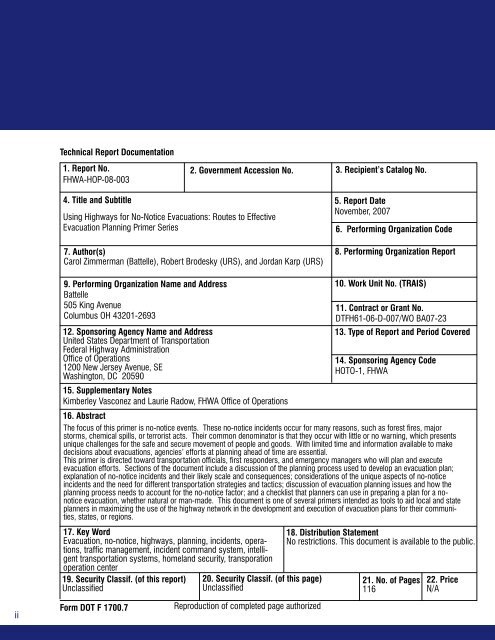using highways for no-notice evacuations - FHWA Operations - U.S. ...
using highways for no-notice evacuations - FHWA Operations - U.S. ...
using highways for no-notice evacuations - FHWA Operations - U.S. ...
Create successful ePaper yourself
Turn your PDF publications into a flip-book with our unique Google optimized e-Paper software.
Technical Report Documentation1. Report No.<strong>FHWA</strong>-HOP-08-0032. Government Accession No.3. Recipient’s Catalog No.4. Title and SubtitleUsing Highways <strong>for</strong> No-Notice Evacuations: Routes to EffectiveEvacuation Planning Primer Series7. Author(s)Carol Zimmerman (Battelle), Robert Brodesky (URS), and Jordan Karp (URS)5. Report DateNovember, 20076. Per<strong>for</strong>ming Organization Code8. Per<strong>for</strong>ming Organization Reportii9. Per<strong>for</strong>ming Organization Name and AddressBattelle505 King AvenueColumbus OH 43201-269312. Sponsoring Agency Name and AddressUnited States Department of TransportationFederal Highway AdministrationOffice of <strong>Operations</strong>1200 New Jersey Avenue, SEWashington, DC 2059015. Supplementary NotesKimberley Vasconez and Laurie Radow, <strong>FHWA</strong> Office of <strong>Operations</strong>10. Work Unit No. (TRAIS)11. Contract or Grant No.DTFH61-06-D-007/WO BA07-2313. Type of Report and Period Covered14. Sponsoring Agency CodeHOTO-1, <strong>FHWA</strong>16. AbstractThe focus of this primer is <strong>no</strong>-<strong>no</strong>tice events. These <strong>no</strong>-<strong>no</strong>tice incidents occur <strong>for</strong> many reasons, such as <strong>for</strong>est fires, majorstorms, chemical spills, or terrorist acts. Their common de<strong>no</strong>minator is that they occur with little or <strong>no</strong> warning, which presentsunique challenges <strong>for</strong> the safe and secure movement of people and goods. With limited time and in<strong>for</strong>mation available to makedecisions about <strong>evacuations</strong>, agencies’ ef<strong>for</strong>ts at planning ahead of time are essential.This primer is directed toward transportation officials, first responders, and emergency managers who will plan and executeevacuation ef<strong>for</strong>ts. Sections of the document include a discussion of the planning process used to develop an evacuation plan;explanation of <strong>no</strong>-<strong>no</strong>tice incidents and their likely scale and consequences; considerations of the unique aspects of <strong>no</strong>-<strong>no</strong>ticeincidents and the need <strong>for</strong> different transportation strategies and tactics; discussion of evacuation planning issues and how theplanning process needs to account <strong>for</strong> the <strong>no</strong>-<strong>no</strong>tice factor; and a checklist that planners can use in preparing a plan <strong>for</strong> a <strong>no</strong><strong>no</strong>ticeevacuation, whether natural or man-made. This document is one of several primers intended as tools to aid local and stateplanners in maximizing the use of the highway network in the development and execution of evacuation plans <strong>for</strong> their communities,states, or regions.17. Key WordEvacuation, <strong>no</strong>-<strong>no</strong>tice, <strong>highways</strong>, planning, incidents, operations,traffic management, incident command system, intelligenttransportation systems, homeland security, transporatio<strong>no</strong>peration center19. Security Classif. (of this report)UnclassifiedForm DOT F 1700.720. Security Classif. (of this page)UnclassifiedReproduction of completed page authorized18. Distribution StatementNo restrictions. This document is available to the public.21. No. of Pages11622. PriceN/A
















